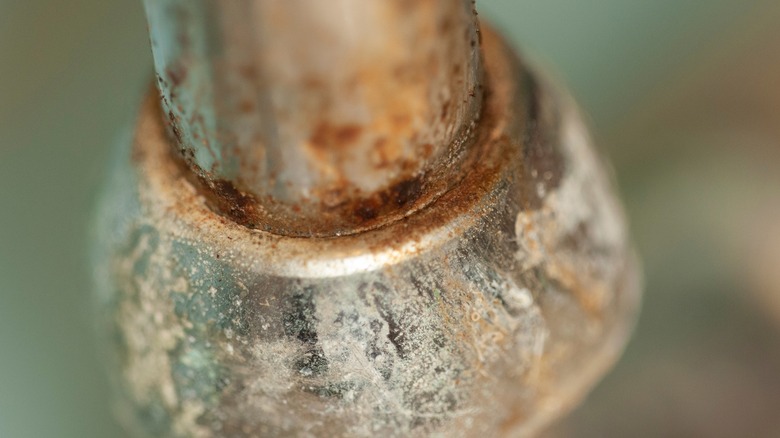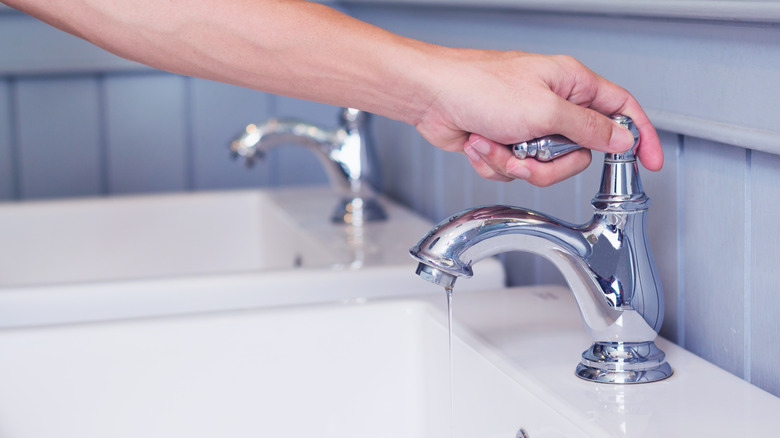Here Are The Top 5 Signs Your Faucet Is Too Old
The faucet is arguably one of the most frequently used fixtures in a house, according to Facets of Lafayette. So it goes without saying that your faucets might need replacing sooner than you think if not correctly cared for. Age is always a factor when deciding if your appliance or fixture needs upgrading, but there are also warning signs that will give you a very straightforward answer. A poorly functioning faucet, or one that visibly shows signs of deterioration, is an automatic no-brainer. If it leaks, or you've already invested more time and money into it than it's worth, then an eco-friendly upgrade is in order.
According to the U.S. Department of the Interior, a slow-leaking faucet (one drip per minute) wastes over 100 gallons of water annually. The United States Environmental Protection Agency says to visualize 100 jugs of milk and note that 2 billion people worldwide don't have access to safe drinking water in their homes, per the Centers for Disease Control and Prevention. It may be time to give your faucet the boot if you're experiencing any of the following faucet fixture symptoms. Your wallet and the planet will thank you.
It has mineral deposits
Mineral deposits aren't just unsightly, they can build up layers inside your pipes and fixtures if left untreated. If that sounds like a water-pressure nightmare, you're right. You can liken the piping in your house to the arteries in your body. You know that eating an unhealthy diet can lead to plaque build-up in your arteries, which ultimately means you'll start dealing with high blood pressure, also known as hypertension. The same occurs when mineral deposits begin to form inside your piping and faucet fixtures. If left untreated, mineral or calcium deposits also enjoy noshing down on any metal surface they come in contact with and are good at eating away certain metals.
So if you just let those calcified crusties do their thing, your faucet will probably become a holey mess and need to be replaced much sooner than expected. One way around this is to invest in specialized treatment like a water softening system, which removes magnesium and calcium from the water through an ion exchange process, per Popular Mechanics. (By the way, HomeWater 101 notes that over 85% of American households deal with hard water.) Your other option is to chuck your problematic piping fixture and invest in an anti-rust or corrosion-resistant faucet. These fixtures, writes Industrial Metal Supply Company, are made with stainless steel, aluminum, galvanized steel, copper, brass, or bronze.
There's rusting
It's a safe bet that if your faucet is rusting out on the outside, it's probably not looking too great on the inside. If the handle is sticky, or it takes a second for the water to get going, or if the water itself has an odor, funky taste, or isn't clear, then you're most likely dealing with corroding piping in a water heater that's gone south. These are much bigger issues than your faucet just looking nasty, warns All American Plumbing Heating & Air. If you're getting brown water flow, you will want to get professional plumbing assistance. That said, your faucet might still be salvageable once the problem is solved, but sediment-infused, rusty water will leave your faucet fixtures scathed, no matter what.
According to Benjamin Franklin Plumbing, no baking soda, pumice stone, or even the tried-and-true vinegar soak will save the inside of a rusting faucet. This is because there's no easy way to get inside the fixture to flush out any rust build-up or try to reverse corrosion. As soon as you see the flaky orange-brown deposits start forming around the base and spigot, your faucet's time is limited. Unfortunately, you will need to start shopping for a replacement and a reputable plumber.
It's leaking
Not only is a leaking faucet annoying, but it's wasteful. Water is a precious commodity, with one in 10 individuals worldwide — over 770 million people — lacking access to safe water, per the global nonprofit Water.org. A leaky faucet could also be due to water pressure issues, which means there's possibly some buildup inside the faucet itself. If this is the case, then giving it a good cleaning isn't going to do much. You can check your water pressure with a pressure gauge, which should read between 40 PSI and 60PSI, notes Fast Plumbers. If it's above that, then high water pressure might be why your faucet has a runny nose, which means you need to call a plumber or start searching for a suitable replacement.
Leaking is never a good sign, but if your faucet is spitting at you, then that's just rude. A spitting faucet (also called a sputtering faucet) is caused by trapped air in the water line, per White's Plumbing, LLC. While this is typically not a sign that your faucet is doomed, it's still something that you should pay attention to. A sputtering faucet could mean that the aerator needs to be cleaned out. Or it could be a cracked pipe or even a malfunctioning water heater. None of which is a good thing.
And making noises
If the faucet handle is squeaking, that can mean there's something bigger going on, and a little plumbers grease might not fix it. According to Beehive Plumbing, you can typically chalk up a noisy faucet to one of four issues. For one, the washer might be the wrong shape or size. You could also have calcium deposit buildup, worn down internal threading, or the issue might not be the faucet but a major piping problem.
Going into a bit of detail on washers, Mr. Kitchen Faucet notes that there are two types: flat and beveled. Beveled washers are rounded on one side and are typically found in older faucets or those that have extensive damage to the faucet seat, also called the valve seat, per Clean Line. Flat washers are pretty much universal and are found in newer faucets. If your washer is wrong or worn, you will get squeaks. A whistling noise could be due to calcium deposits restricting the water flow. If your faucet handle squeaks when you turn it, this could be due to worn internal threading. In other words, the noise you're hearing is metal on metal and could be temporarily fixed with petroleum jelly or plumbers grease. It might seem minor, but that means your faucet is beginning to show signs of wear and tear.
It's past its prime
With proper care, a faucet can last anywhere from 15 to 20 years, according to Home Inspection Insider. Ultimately, how well it's made, who installed it, how well it was maintained, and water quality plays a part. As noted by Kitchen Infinity, a lower-quality faucet will last between 5 and 10 years. If installed by a professional or a personal project, it might also play a role in preserving the integrity of your faucet fixture. That's all dependent on skill level, though. After all, some professionals are imposters, while some DIYers are pretty adept at home installation hacks.
Did you ever clean the aerator or replace the O rings? If not, you can knock off a year or more of your faucet's life expectancy. Lastly, how was your water quality? Did you use a water softener? Or did mineral-dense municipal water flow straight through your fixture? This isn't the nail in the coffin, per se, but it holds its weight regarding faucet life expectancy. As previously noted, hard water builds up calcium and mineral deposits internally and externally. In the end, if you're experiencing any of the above issues, fixed them more than a few times, and your faucet is getting up there in years, it's safe to say it's time for a more eco-friendly upgrade.





